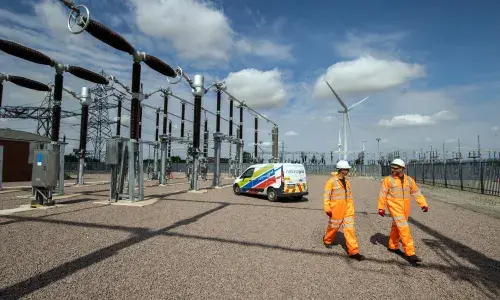
Why electricity interconnection between Europe and the UK matters
To achieve a cleaner energy future, the EU and the UK need to work closely together on the energy transition. We share similar strategic climate targets, including a legally binding approach to net zero by 2050, and our markets have been built together for decades as part of the Internal Energy Market.
The EU-UK Trade and Cooperation Agreement recognises the critical role of efficient cross‑border trading arrangements to facilitate the growth and integration of renewables. Our electricity interconnector experience starts from 1986 with the IFA link (France – UK) and, over the last 10 years, National Grid has invested more than €2.5bn in new interconnector capacity connecting to Europe.
What value do interconnectors bring to the EU and the UK?

1. Supporting sustainability goals
We estimate that by 2030 the GB power sector could reach net carbon-negative emissions and is therefore expected to become a net electricity exporter to Europe by 2050.
With EU renewable generation expected to double from 32% of the total electricity mix up to 65% by 2030, this will result in significantly higher volatility, which only underlines the value of interconnectors (see the graph).
The ability to export excess generation to where it’s needed most prevents the curtailment of renewables. Wind, and renewable energy sources in general, will supply more than three quarters of demand during export periods. In the absence of exporting options, we estimate that the curtailment of renewables could be up to six times higher.
Interconnectors can provide more flexibility and cost-efficiency, fulfilling the potential of renewables by transporting the excess power and meeting consumers’ demand on both sides of the Channel.
2. Delivering improved security of supply and flexibility with more renewable energy sources
Nemo Link is one example of the value of interconnection between mainland Europe and Great Britain. With availability of over 98%, Nemo Link is one of the most reliable interconnectors in the world, with over 12 TWh of electricity imported and exported.
Although GB is predominantly importing electricity from Europe, there are also situations when GB’s exports prove to be decisive in situations of power shortage issues followed by a series of trips on the European transmission network, significant electricity demand and skyrocketing prices, or nuclear power plant outages. These are rather infrequent situations, but they stress the relevance of interconnections and the overall positive value they bring to consumers.
3. More flexible, competitive markets and lower prices
National Grid Ventures’ (NGV) interconnectors can play an important role in enhancing the European energy market and enable the efficient integration of new renewable energy sources via market products like intraday commercial flow mechanisms. Along with EU member states, phasing out nuclear and coal, NGV interconnectors help to ensure electricity is available where needed.
What’s next?
In the coming years, the North Sea could become a wind powerhouse with a potential for up to 220 GW of offshore wind generation, making a significant contribution to meeting Northwest Europe’s electricity demand.
NGV currently has connection agreements in place for 6.4 GW of interconnector capacity, which could connect up to 12.8 GW of offshore wind. We are now working with our European partners to develop a vision for offshore hybrid projects / multi-purpose interconnectors.
Image

|


